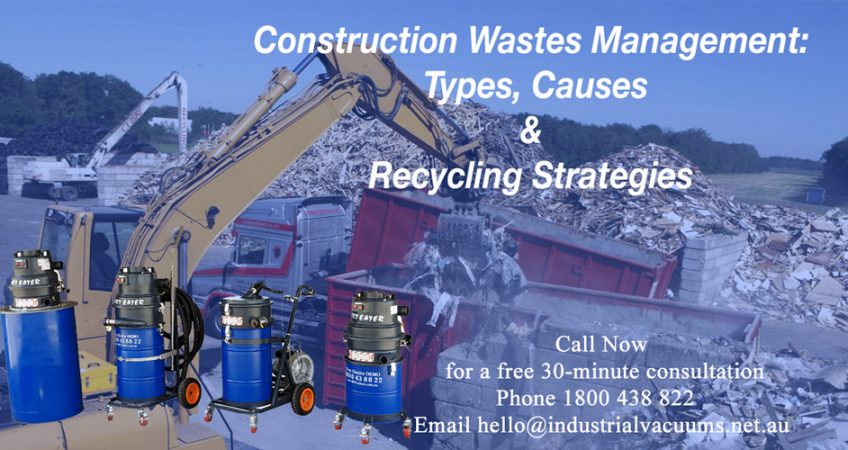Construction Waste Management: Types, Causes, and Recycling Strategies
The construction industry plays a rapid role in the socio-economic development of any country. This growth has contributed significantly to waste generation. Waste or debris produced during the construction, rehabilitation, and demolition of buildings, roads, bridges, and other structures majorly constitute construction waste. This hazardous waste poses a great danger to the environment, economy, and social aspects. Sustainable and responsible management of waste includes a range of comprehensive strategies such as: Reduce – eliminating waste where feasible; minimizing waste where possible, Reuse – reusing materials which might otherwise become waste, and Recycle – redirecting recyclable recovered resources back to the manufacturing process. Typically, construction waste materials fall into two categories:
- General – Drywall, clean dimensional wood, windows and glass, roofing material, fixtures, metal, wiring, and ductwork.
- Heavy Duty – Brick, block, concrete, asphalt, stone, and gravel.
All construction sites generate these waste that pollutes large landfills over a long period.
Problem Area
Construction waste contributes significantly to the polluted environment. This increasing awareness around environmental impacts from construction wastes has led to the development of a waste management plan as an important function of construction project management.
The construction and demolition process is considered to be a major source of waste in terms of weight, volume, and quantities. So, how should you manage all of that waste?
Construction waste management plan
There are different approaches to construction waste management. The whole process is far beyond just disposal of waste, it is an all-encompassing sustainable strategy towards effectively utilize construction resources. Comprehensive strategies such as reduce, reuse, and recycle (three R’s of waste management) comes in with the views of reducing the quantity of waste and also utilizing the generated waste most effectively.
Reduce: Cutting the amount of waste, with careful planning can reduce the quantity of waste produced. This can be beneficial to the environment in the first place. Here are some suggestions:
- Encourage minimal construction designs.
- Be careful while ordering materials.
- Make sure to use standard sizes and quantities of materials.
- Allow materials to arrive on-site to match the work stages.
- Build your storage areas safe and weatherproof.
Reuse: Throwing away or keeping behind perfectly good surplus material on the site, is a waste of resources. Using them to the same or on another project can be beneficial to cut costs around the project. The following materials can be reused:
- Bricks and tiles.
- Concrete, soils, stones, and asphalt.
- Doors and windows.
- Timber and wooden pallets.
- Metal accessories.
Recycle: Recycling is a crucial effort to prevent waste materials from ending up in the landfill. Recycling haves the potential to turn non-hazardous waste back into brand new construction material. The successful recycling can be done with proper segregation of waste. It is the most effective approach that helps reduce the amount of unnecessary waste in the landfill, helping to minimize environmental damage and cut costs on construction projects. Some of the recyclable construction materials and their new form:
- Wood for energy generation.
- Bricks, concrete, soil, and stones for aggregate materials and new concrete or asphalt.
- Expensive plasterboard for new plasterboard.
- Metal to high-quality metal
Solution
Green building is the future of the construction industry. The concept isn’t new but has never been important. Green construction is also called sustainable building, it is the concept of creating structures that are environmentally responsible and resource-efficient throughout its life-cycle. The design, construction, operation, maintenance, renovation, and deconstruction – everything aims to reduce the impact of a building on the environment.
Green buildings are designed to preserve resources like raw materials, energy, and water. It aims to bring comfort and health to occupants as well as the environment. The use of the material is of high sanitary and environmental quality. Construction companies and contractors should promote sustainable green construction so that when it comes to destruction, it doesn’t hurt the environment.
Conclusion
A Certified Type H Industrial Vacuum Cleaner that uses Plastic Bag(Azzy Bag) to collect contaminated dust, equipped with Over-Size HEPA Filter, great suction power, 10M Long hose, and Heavy Duty Industrial Tools is an answer to above problems. A vacuum that works, easy to decontaminate, handles the construction dust like a champion, strong build, and easy to move. In Short, Durt EATER is Modular enough to scale up or down when required.

